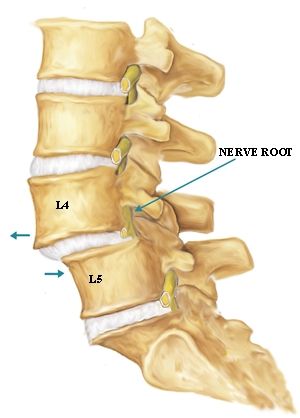


The body weight is supported and the spinal cord is protected by the spine which is present from the bottom of the skull to the pelvis region. The spine has a characteristic "s" shape which gives the ability to tolerate immense amount of stress and allows it to distribute the body weight evenly. A case of spondylolisthesis or anterolisthesis such as grade 1 anterolisthesis can lead to pain in your spine.

Vertebrae are the bones which construct the spine and allow an opening for the spinal cord by forming a passageway. The spine is comprised of 24 bones with the coccyx consisting of four bones and the sacrum consisting of 5 bones. The flat intervertebral discs which separate the stacked bones act as an absorber of shock for the vertebra and the spinal cord.
Anterolisthesis can lead to pain in the vertebrae of the spine. It is a condition where the vertebra in the upper body slips forwards on the vertebra in the lower body. As this displacement of the vertebra progresses, it can possibly pinch the nerves of spine which can lead to damage of the spinal cord. Anterolisthesis is usually detected in the 4th and 5th lumbar vertebrae and is one of the types of spondylolisthesis, describing the manner in which the vertebra has slipped.
The degree of the slippage of the vertebrae determines the grade of anterolisthesis. The identification of the grade of anterolisthesis can be done with the help of lateral radiograph using the plain x-ray. Anterolisthesis can be divided into 5 grades and the first grade is least severe. This stage only has a slippage of about 25%.
Anterolisthesis has several symptoms which are dependent on the severity of nerve damage or pinch due to slippage and also the region affected by forward slippage. Hence, grade 1 anterolisthesis has mild symptoms.
This symptom is the most easily noticeable and common type of symptom detected by people suffering from anterolisthesis.
Anterolisthesis may result in pain from muscle spasm due to aggravated tissue near the spine, disc and nerve roots. The pain can be either localized or diffused from the area of slippage. This pain may be reflected in the legs which can be perceived as weakness of one or both legs, which requires urgent medical attention.
Several factors such as age, severity of slippage, general health and extent of symptoms influence the treatment for anterolisthesis. For example, grade 1 anterolisthesis would require less treatment. Treatment is usually conservative which involves rest, exercise and medication. Only in severe cases surgery is required.
An exercise program of 2 to 3 months is required to achieve strengthening of back and abdominal muscles. This helps in minimizing the slippage of the spine and increasing muscle strength and flexibility. Below are some sample exercises:
For grade 1 anterolisthesis, the above initial treatment can be of great help. But if they fail to relieve pain due to slippage of vertebrae which interferes the day-to-day activities, then surgery shall become necessary.
Surgery is mainly performed to reduce pain caused by the inflamed nerve, increase the functional ability of a person and balance the spine where slippage has occurred. Generally there are 2 procedures to treat anterolisthesis. They are: